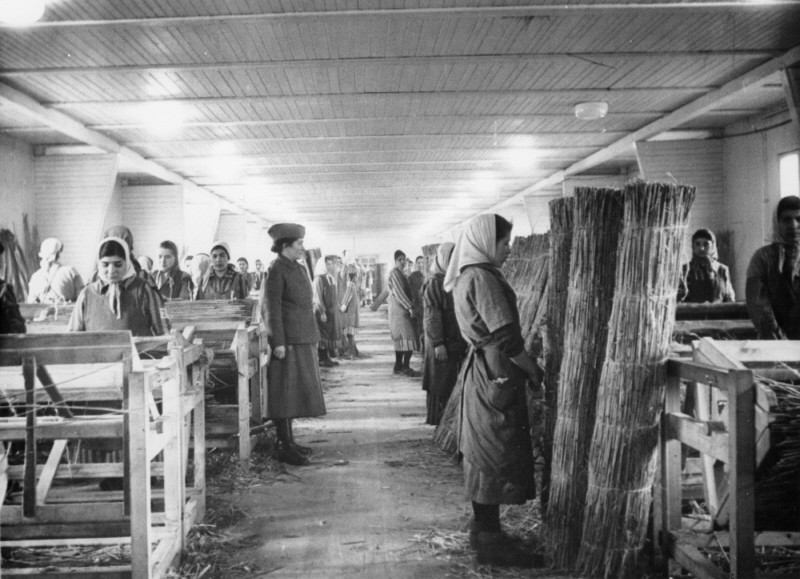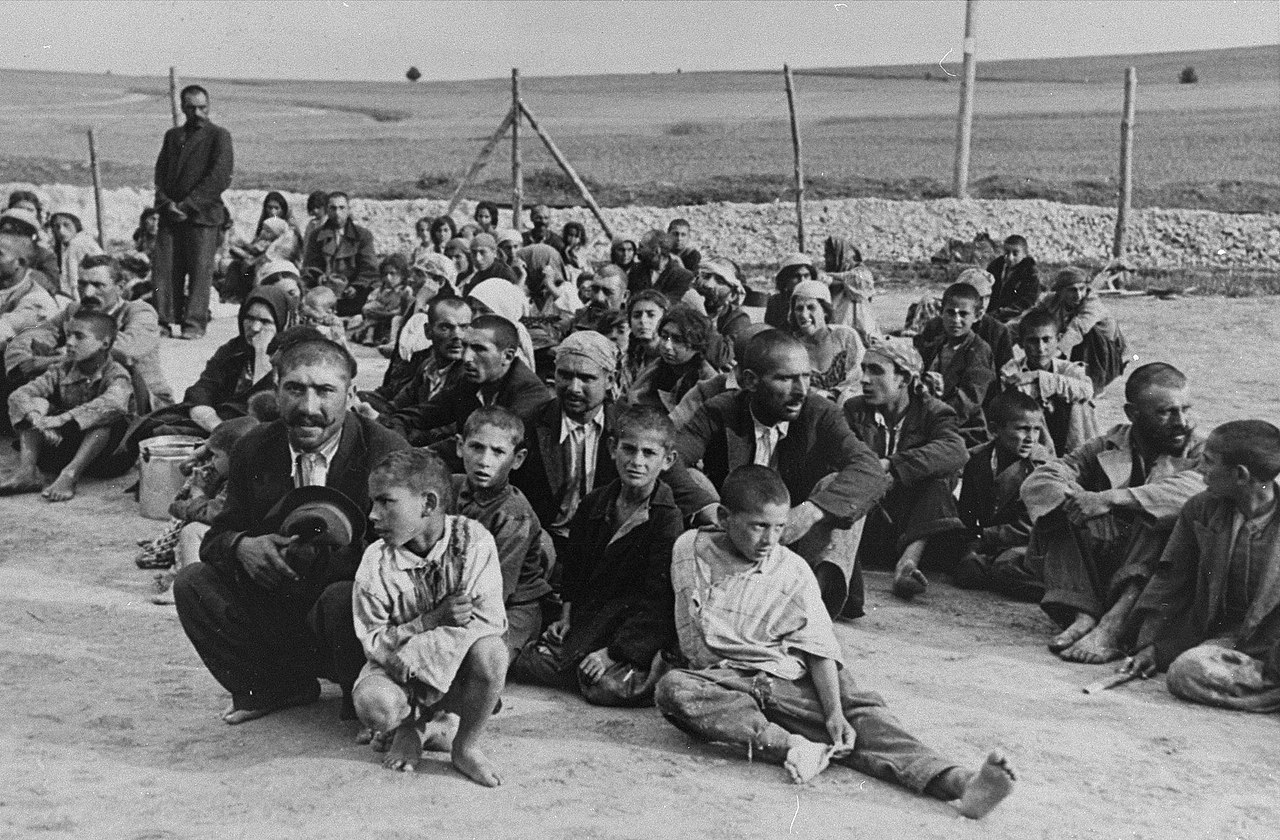Find out about The Open University's History courses and qualifications
[Our] ash was mingled in the ovens - why should we be remembered separately…?
(Woolford & Wolejszo S, 2006).
 Forced Roma female labourers at Ravensbruck concentration camp
Forced Roma female labourers at Ravensbruck concentration camp
The Roma (also known as Gypsies, Travellers, Sinti, Romani) are one of Europe’s oldest ethnic minorities. Scholars believe that they migrated from the Punjab region of India 1,500 years ago, probably as a result of the invasion of Alexander the Great. Like the Jews, the Roma have been persecuted since the Middle Ages; subjected to enslavement, expulsion and laws seeking to destroy their culture. In the twentieth century, the Nazis planned the elimination of both the European Jewry and Roma. They were deemed racially ‘undesirable’ and stripped of their citizenship rights by the Nuremberg Race Laws, forced into ghettos and deported as forced labour to concentration camps where they suffered from starvation, disease, freezing conditions and the brutality of the guards. At the Auschwitz concentration camp, in Poland, children and adults from both communities died as a result of barbaric ‘medical’ experiments and they were murdered in its gas chambers. It’s estimated that 500,000, 25% of the Roma pre-war European population, perished as a result of Nazi persecution. The genocide is known as the Porrajmos; the ‘devouring’.
Since the war, the Roma have continued to be discriminated against
In the post-war period, the victims of Nazi persecution had to demonstrate to the German Federal authorities that they had suffered racial, religious, or political persecution in order to gain financial compensation for the Nazi war crimes. Jewish suffering was recognised more readily, and more sincerely. The Jews were deemed to be innocent of blame by the compensation administrators. In contrast, the Roma were ‘lesser’ victims, believed to have been justifiably persecuted by the Nazis for their criminality, rather than for their race. In refusing compensation, the German officials drew on historic stereotypes of the Roma as anti-social.
In the 1950s, agreement was reached to compensate the Jewish victims of the Nazis. However, it was not until the 1980s and 1990s, after a determined campaign that involved hunger strikes by three concentration-camp survivors, that the Roma were recognised as victims of racial persecution and mass murder. By then, clearing the Roma of responsibility for their treatment by the Nazis was too little, too late, as many victims had died before compensation was paid.
 Roma victim of Nazi 'medical' experiment
Roma victim of Nazi 'medical' experiment
In post-war Eastern Europe, a policy of forcefully sterilising Roma women, that had originated with ‘scientists’ working with the Nazis, in the 1930s, persisted until the 1980s. The powerful craft history to their own ends, and the communists sought to wipe the Roma from cultural memory. In Czechoslovakia, a pig farm was built over the site of a Roma concentration camp. And it was not until the post-communist period that Roma and Jews were acknowledged in museum exhibitions. Though, once again, the Roma were presented as ‘lesser’ victims, added as an afterthought to the historical accounts of the Jewish Holocaust.
These are dark-skinned people, not Europeans like you and me
their contemporary existence is absolutely dysfunctional
These statements aren’t from the historical archives. They were made by Italian and Hungarian politicians, respectively, in 2010. A European Union survey, in 2019, found the Roma are increasingly threatened by the far right across Europe. Moderate policy makers have also targeted them. The current leader of the Scottish Conservatives, Douglas Ross, when asked in 2017 what his ‘first priority’ would be if he became PM answered, ‘tougher enforcement against gypsies and travellers’.
The UK’s Roma are a diverse and dispersed community that continues to suffer social marginalisation. Contrary to the stereotype, the majority live in permanent housing. Gathering accurate statistics about the community experience is difficult, as the Roma are generally reluctant to reveal their identity for fear of persecution. However, the evidence suggests that they suffer discrimination in all spheres of life.
According to the British Medical Association, the community has the highest rates of child mortality in the UK and Roma life expectancy is 7-20 years lower than the rest of the population. There is also a concern about the impact of coronavirus on the disadvantaged community as the facilities at local authority sites are often extremely poor. Ofsted associates the low level of Roma educational achievement with the children’s disrupted schooling and anti-Roma bullying by their peers. And the Westminster parliament, in 2019, identified that Roma victims of domestic abuse face greater barriers than the non-Roma. It is harder for them to secure the employment and housing they need to leave their abuser. The centrality of family and community to Roma culture developed as a protection against the prejudice of mainstream society. In this situation, Roma women are reluctant to report abuse, fearing ostracism from their extended family and expecting discrimination by wider society.
How is anti-Roma prejudice being tackled?
- 2 August is recognised as European Roma Holocaust Memorial Day. This was the date, in 1944, when up to 5,000 Roma men, women and children were murdered in the Auschwitz crematoria.
- At the International Roma Conference 2016 the Indian Minister of External Affairs recommended that the Indian government recognise the world-wide Roma community as part of the Indian diaspora.
- A European Roma-led truth and reconciliation commission has been established to raise awareness of the Roma’s historical and ongoing persecution.
- A dedicated Roma exhibition and memorial is due to open in the Czech Republic, in 2023, on the site of the Roma concentration camp mentioned earlier. The pig farm has already been demolished.
- Amnesty International, and other human rights’ groups are campaigning against Roma prejudice.
- In July 2020, the president of the European Commission called on Member States to ‘end racism and discrimination, which blatantly affects our large ethnic Roma minorities’.
- Across the UK, hate crime is a criminal offence and it includes online and offline hate speech.
The Roma themselves don’t want to be seen solely as victims. As well as commemorating 2 August as Holocaust Memorial Day, they mark 16 May as Resistance Day. On 16 May 1944, Roma prisoners sabotaged Nazi attempts to transport them to the Auschwitz gas chambers. This inspires their determination for their culture and positive contribution to Europe to be recognised. This is a determination many non-Roma share.







Rate and Review
Rate this article
Review this article
Log into OpenLearn to leave reviews and join in the conversation.
Article reviews